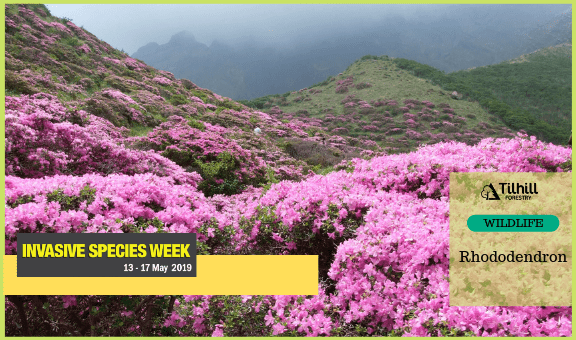Rhododendron
This week Tilhill Forestry will be sharing their Toolbox Talks on Invasive Species for Invasive Species Week including the Do’s and Dont’s when dealing with them.
WHAT?
Rhododendron ponticum is an invasive non-native woody shrub species. First introduced in the late 18th Century it was planted for its ornamental value and as cover for game.
WHY?
Rhododendron acts as a host for the fungus-like pathogen Phytophthora ramorum (otherwise known as Sudden Oak Death): see Toolbox Talk TT/44).
Clearance is undertaken to prevent the spread of this virulent plant disease and to improve woodland structure and biodiversity.
WHAT?
Key facts:
• Phytophthora ramorum is an aggressive disease which kills a wide range of trees and shrubs.
• If you work on known infected trees you will have to comply with strict control measures and observe biosecurity practices.
• It is a legally notifiable disease. This means that the Forestry Commission can:
– serve a notice on an owner to fell infected trees (Statutory Plant Health Notice SPHN).
– control/ban the movement and processing of infected material, including wood chips.
– enforce biosecurity measures to restrict the spread (eg pressure cleaning of equipment before it leaves the site, disinfecting boots and tools, debarking timber).
• Failure to comply could result in a fine of up to £5,000 per offence.
Background:
• Phytophthora ramorum first came to the UK in 2003 on rhododendron. In summer 2009 it was found on Japanese larch which is a commercial conifer of some importance in the UK.
• It is currently causing problems in SW England, Wales and Western Scotland. We expect the disease to spread to other areas over time. The disease kills larch but infected larch produces vast quantities of spores which can then go on to infect other plants. Larch is therefore an efficient vector for the disease.
• There is no cure or treatment.
• Positive identification of the disease requires a lab test, carried out by the Forestry Commission, following aerial surveys looking for dead and dying larch trees.
• Lots of information can be found on the Forestry Commission website: (www.forestry.gov.uk).
Symptoms:
• On rhododendron – leaf blackening (from the stalk, along the mid vein), wilted shoots, shoots dying back and hanging down.
• On larch – needles fall off, branches die back, the crown of the tree looks weak with few needles, sometimes with a heavy crop of cones. In severe cases the crown dies then the whole tree dies. Bleeding cankers are sometimes seen on the stem.



OPERATION:
Cutting of individual stems with hand or chainsaws.
Rhododendron plants can form dense tangles of interlocking stems in which tension and compression wood occurs. Cutting into the tension wood of even relatively small material can release considerable force and cause the stems to spring back towards the operator – with the risk of injury.
• On bent stems and branches, identify where tension and compression wood is likely to occur.
• Whenever practicable work from butt to tip making the initial cut into the compression wood.
• All cuts must be watched carefully to ensure the expected reaction is occurring. In particular, be aware of hidden side tension or twisting that may result in the cut pinching on one side of the stem.
• Always adopt a secure and balanced stance before engaging the saw.
• On sloping ground assess the terrain for loose material and work up from the base of the slope.
• Check and maintain the chain tension on a regular basis to maximise efficiency and reduce the risk of HAVS.
• Work in a systematic way to ensure brash material does not build up, to reduce the risk of slips, trips and falls and to maintain control when operating the saw.
• Where necessary, follow bio-security protocols. Remove soil and mud from footwear, equipment and machinery before leaving the site and spray with a disinfectant.
DO ✅
✅Ensure each chainsaw operator carries a large wound dressing with them at all times.
✅Wear appropriate PPE and footwear providing good grip and ankle support.
✅Consider the effects of weather conditions.
✅ Use the chainbrake when moving around the work area.
✅ Plan the cutting of each individual bush.
✅ Use a fall restraining system on sloping ground as per Tilhill Forestry MS.
DON’T ❌
❌ Work on severe slopes without first risk assessing the operation – refer to the procedure for working on slopes.
❌ Work directly in line with one another on sloping ground.
❌ Work within 5m of each other or if visitors approach within 20m.
❌ Use the saw above shoulder height.
❌ Work alone.




